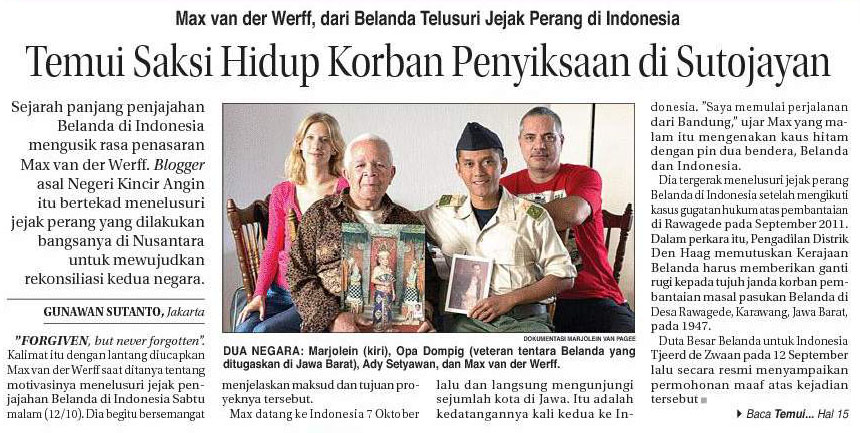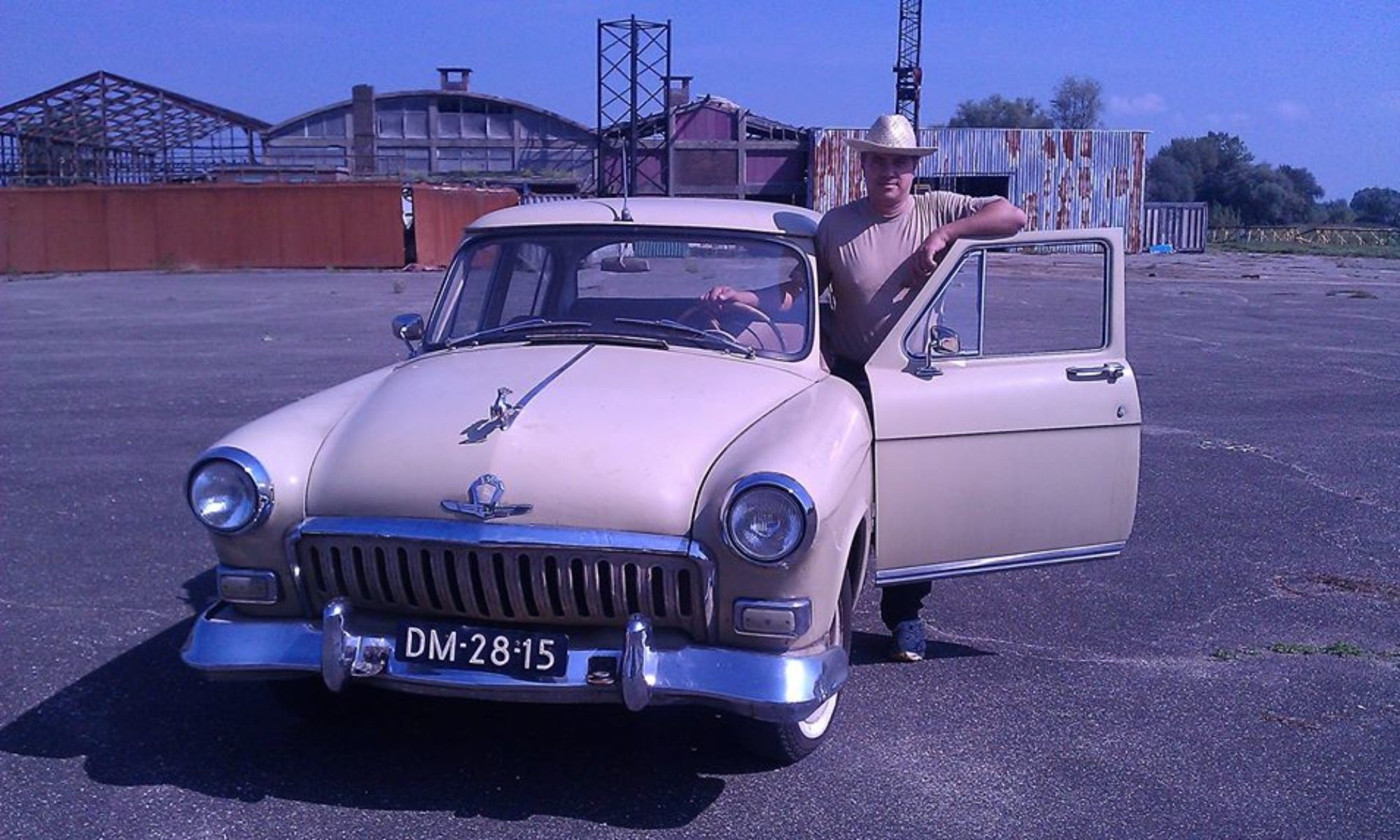October 16, 2013
Jawa Pos, Front page. Gunawan Sutanto, Jakarta
Max van der Werff from The Netherlands tries to find old traces of the Indonesian Independence war.
Found one of the victims from torturing in Sutodjajan alive

Photo: two nations: Marjolein (left) opa Dompig (Dutch veteran who was assigned in West Java) Ady Setyawan and Max van der Werff
Max is interested in the history of Dutch colonialism in Indonesia. this Dutch blogger went to Indonesia to find the story about what his ancestors did in Indonesia and also to build reconciliation between our two nations.
“Forgiven, but never forgotten.” That’s what Max said when I asked him about his motivation to do this research in Indonesia. Last Saturday night October 12, he is so excited to explain his purpose and his project.
Max came to Indonesia on October 7 and visited some cities in Java. This was his second visit to Indonesia. “I start my trip from Bandung” Max explained, he is wearing a black t-shirt with a Dutch and Indonesian pin on his chest.
He started his research after he read about the case of the Rawagede massacre on september 2011. In that case, the court of The Hague decided that the Dutch government must pay 7 of the Rawagede widows who are still alive. The incident took place at Rawagede village, Karawang, West Java, 1947.
On september 12 2011, Dutch ambassador in Indonesia Tjeerd de zwaan officially apologized for that incident: read more on page 15, extended version
“Rawagede case was a wake-up call, I’m sure there must be another similar case which are still hidden in Indonesia.” Says Max.
In his life this man, who work as a business consultant, has always been interested in history. He even collected some Dutch documents as proof of very bad things such as massacres in Indonesia. For example he has some photos of executions of Indonesians which are committed by Dutch troops.
Those documents moved his heart to take action: go to Indonesia to find the facts. His first visit was in 2011, after th Rawagede trial. “The first place I visited was Bandar Boeat (Padang) and Sutodjajan (Malang). This father of a son and two daughters explained.
What happened in Bandar Boeat is a Dutch airstrike. While using Mustang fighterplanes, they bombed a traditional market. Hundreds civilians were killed during that incident in 1947.
And at Sutojajan village, the Dutch troops burnt down the village and also tortured some villagers. He found one survivor, even until today we can see his wounds caused by Dutch torture.
During the attack of Sutojajan village, there were three Marines who didn’t obey the orders, they refused to burn down that village. Now Max also has a good relationship with the family of those three Marines.
After his first trip to Indonesia, Max met Marjolein van Pagee, also an independent researcher who has the same interest about the Independence war in Indonesia.
Marjolein also did research in Indonesia about ‘politionele acties’ together with Ady Setyawan. Our newspaper also covered about her research and trip. We interviewed this young woman who was born on May 2, 1987 at Ady Setyawan’s house.
Through Marjolein, Max got to know Ady. So during his second visit to Indonesia, Max did his research together with Ady. Both of them have the plan to publish a book called: “Excessennota 2015”, with “The last victim.” as subtitle.
“We want to write history from both sides, Dutch and Indonesian.” Max says. Last September Ady also went to the Netherlands to interview Dutch veterans aw well.
Ady said that the word “excessennota” means war crime record. The first excessennota was written by Fasseur, a Dutch historian and published in 1969. The excessennota was written because of the confessions of a Dutch veteran Joop Hueting. “The record was based on Dutch military files only, without checking evidence or location on the field” Ady says.
Max and Ady have plan to launch their book on 2015. Why wait for 2 more years? “It will be 70 years Indonesian Independence, and we need to collect more prove to make our book more accurate and detailed, not just only telling stories.” Explains the man who was born in Arnhem, January 1963.
This book will also be an attempt for reconciliation between our two nations. They intend to write fair content, from primary data (interviewing both sides involved) and secondary data (archive and photos) from both sides also.
Before this, Ady and his friends from Roodebrug Soerabaia community (who has interest for history) also did the same thing: interviewing veterans of the Independence war in Indonesia.
Max also expects that their book will be a first step of reconciliation between the two nations. “We must forgive what happened in the past but we should never forget, because that’s the part of our history”. Max says.
For Ady as an Indonesian, doing such a thing is easier than Max, because many groups in the Netherlands didn’t like with what Max did. Max having interest in this case also caused by his family history, his grandpa was a KNIL soldier married an Indonesian woman and from them Max Senior was born.
“My grandpa and father never told me about their story in Indonesia, every time I asked him he always replied that he didn’t remember.” Max said.
In 1956 my father moved to the Netherlands, and one day Max found an old photo of his father with complete TKR uniform with caption bandung 1946. “My father already passed away, I can’t ask him the story behind his uniform.” This mystery inspired him to look closer to the Dutch war in Indonesia. Also because of that photo Max start his journey from Bandung.
During his second visit, Max came to places where the killing incidents happened. start from Mandala Wangsit TNI museum and Pandu graveyard (Bandung), Candi village and Temanggung (Mid Java) and Sumberejo (Malang)
Some of his journey experiences were written on his blog www.7mei.nl. He chose 7 Mei as his blog’s name to honour one of the Rawagede survivors: mr. Saih bin Sakam, this man passed away on May 7 2011, only 4 months before he won his trial in the Dutch court.
Even the book will be released in 2 more years, Max feels that he must finish his history project. Because the witnesses and the veterans are old. “They will not live forever, when all of them passed away where can I get the stories?” Max says.
Website Marjolein van Pagee
Website Roode Brug Soerabaia
